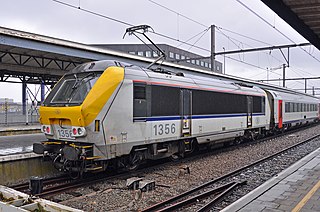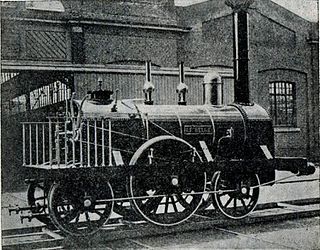The National Railway Company of Belgium is the national railway company of Belgium. The company formally styles itself using the Dutch and French abbreviations NMBS/SNCB. The corporate logo designed in 1936 by Henry van de Velde consists of the linguistically neutral letter B in a horizontal oval.

The Class 13 are a type of mixed use 200 km/h (124 mph) multivoltage electric locomotive of type Traxis designed by Alstom in the late 1990s for the Belgian and Luxembourgish railways.

SNCB Class 22 Locomotives were owned by the National Railway Company of Belgium, also known as Nationale Maatschappij der Belgische Spoorwegen or Société Nationale des Chemins de fer Belges, the Belgian national railway operator.

Belgium was heavily involved in the early development of railway transport. Belgium was the second country in Europe, after Great Britain, to open a railway and produce locomotives. The first line, between the cities of Brussels and Mechelen opened in 1835. Belgium was the first state in Europe to create a national railway network and the first to possess a nationalised railway system. The network expanded fast as Belgium industrialised, and by the early 20th century was increasingly under state-control. The nationalised railways, under the umbrella organisation National Railway Company of Belgium (NMBS/SNCB), retained their monopoly until liberalisation in the 2000s.

The Caledonian Railway 721 Class was a class of 4-4-0 steam locomotives designed by John F. McIntosh for the Caledonian Railway (CR) and introduced in 1896. All survived to be absorbed by the London, Midland and Scottish Railway (LMS) in 1923 and a few survived into British Railways (BR) ownership in 1948.

The NMBS/SNCB Type 12 was a class of 4-4-2 steam locomotives built in 1938–1939 for the fast lightweight Ostend boat trains operated by the National Railway Company of Belgium.

The NMBS/SNCB Type 1 was a class of 4-6-2 steam locomotives built in 1935 and 1938 for working heavy express passenger trains operated by the National Railway Company of Belgium (NMBS/SNCB).

The Iris is an express train that links Brussels Midi/Zuid in Brussels, Belgium, with Chur station in Chur, Switzerland.

The Étoile du Nord was an international express train. It linked Paris Nord in Paris, France, with Brussels, Belgium, and, for most of its existence, also with Amsterdam CS in Amsterdam, the Netherlands. Its name meant literally "Star of the North", and alluded not only to its route heading north from Paris, but also to one of its original operators, the Chemin de Fer du Nord.

The Vauban was an express train that linked Brussels Midi/Zuid in Brussels, Belgium, with France, Switzerland and Italy. Introduced in 1988, it was operated by the National Railway Company of Belgium (NMBS/SNCB), the Chemins de Fer Luxembourgeois (CFL), the SNCF, the Swiss Federal Railways (SBB-CFF-FFS), and the Italian State Railways (FS).
The Belgian State Railways was the original state-owned railway of Belgium. Established by an organic law of 1 May 1834, it began construction of its first line, between Brussels and Mechelen on 1 June 1834. This line, which was opened on 5 May 1835, was also the first steam-powered public railway in continental Europe.

The Belgian State Railways Type 7, later known as the NMBS/SNCB Type 7, was a class of 4-6-0 compound locomotives built between 1921 and 1924.

The NMBS/SNCB Type 26 was a class of 2-10-0 steam locomotives built between 1945 and 1947. Originally commissioned as part of an order for 200 DRB Class 52 Kriegslokomotiven placed by the Deutsche Reichsbahn (DRG) with Belgian locomotive manufacturers in 1943, the 100 members of the Type 26 class were completed for the National Railway Company of Belgium (NMBS/SNCB) following the liberation of Belgium late in 1944.

The Belgian State Railways Type 10, later known as the NMBS/SNCB Type 10, was a class of 4-6-2 steam locomotives built between 1910 and 1914.

The Belgian State Railways Type 23, later known as the NMBS/SNCB Type 53, was a class of 0-8-0T steam locomotives built between 1904 and 1927.

Herbesthal railway station was the Prussian/German frontier station on the main railway from Germany into Belgium between 1843 and 1920. It opened to rail traffic on 15 October 1843, and was thereby the oldest railway station frontier crossing in the world. It lost its border status on 10 January 1920, however, as a result of changes mandated in the Treaty of Versailles, which left Herbesthal more than 10 km inside Belgium.

The China Railways KD7 type steam locomotive was a type of 2-8-0 mainline general purpose steam locomotive. KD7 locomotives were built in the United States and supplied to China by UNRRA as part of the post war rehabilitation effort in 1946. China received 160 locos while others of the same design went to Belgium as NMBS/SNCB Type 29.

The NMBS/SNCB Type 64 was a class of 4-6-0 steam locomotives built as Prussian P 8s for German railways, delivered as war reparations to Belgium at the end of World War I. 168 locomotives of this type were delivered to Belgium, working mostly on light passenger trains operated by the National Railway Company of Belgium (NMBS/SNCB). The final locomotives of this type were withdrawn in 1967, marking the end of steam service in the country.

The NMBS/SNCB Type 36 was a class of 2-10-0 Decapod steam locomotives built from 1909 to 1914 for heavy freight service in Belgium operated by the National Railway Company of Belgium.

















